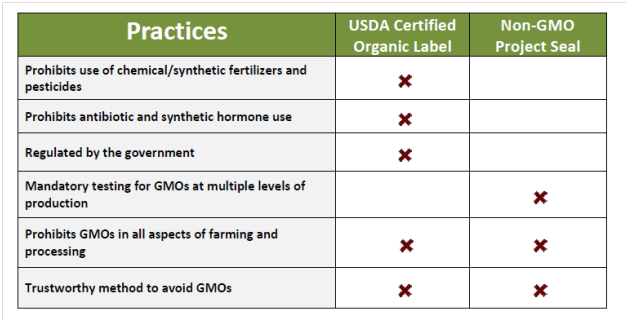With the failure of the Federal Government to pass any legislation mandating the labeling of GMOs, and the uphill battle states are fighting to establish a right to know, consumers are looking for alternative options that allow them to choose whether or not the food they are eating contains GMOs. Consumers have two main options for avoiding GMOs at the grocery store including Non-GMO Project Verified and USDA Certified Organic. Market research from the Hartman Group, as well as questions we get regularly at GMO Inside, demonstrate that there is confusion about what each of these labels mean, as well as the validity of each. Many consumers wonder if organic products can contain GMOs, or if non-GMO means less pesticides in their foods.
In 2001, the FDA, unwilling to set standards for the labeling of GMOs, issued draft voluntary labeling guidelines that allow companies to label products non-GMO or GMO if they choose. Unsurprisingly, no one has voluntarily labeled products that contain GMOs. The only requirement for these labels is that they should not be misleading. If a manufacturer chooses to label their products GMO-free there is no system of checks and balances to confirm the validity of this statement. By contrast, products containing the Non-GMO Project Verified symbol have been verified by the Non-GMO Project, a third-party nonprofit that tests for the presence of GMOs. Products that are USDA certified organic cannot contain GMOs and are regulated by the USDA.
Consumer Reports recently released a study comparing the validity of the labels and offered insights into which labels tested true. The study found that the Non-GMO Project Verified and USDA organic labels are the most trustworthy. The products met the .9% threshold held by each of these standards (meaning that no more than .9% of the product contains GMOs). Both of these labels provide a guarantee that the product is non-GMO. Consumer Reports did give slightly more standing to the Non-GMO Project Verified label, as the standard requires testing of all ingredients included in a product whereas organic uses process inspection to document the lack of GMOs rather than verification testing. Organic-certified farmers have to document that they are not using GMO seed for their farm to meet Organic standards, but it is possible that GMO seed can drift into their fields from nearby conventional fields. Additionally, Consumer Reports tested products that were self-labeled by the manufacturer as non-GMO and not verified by a third party which also tested GMO-free and met the .9% threshold. However, transparency is key, and it is possible that as more companies self-declare that their products are GMO free that errors will creep in, so look for third-party verification.
Both organic and Non-GMO Project Verified labels are great ways to avoid GMOs and provide transparency for consumers about what’s in their food and how it was produced. Overall, GE crops have encouraged systematic changes in our food and agricultural systems. Industrialization and consolidation of agriculture has led to increased herbicide use (with a huge increase in glyphosate, the active ingredient in RoundUp), dependence on synthetic fertilizers, and monocropping, just to name a few. GE crops have also had a major impact on the formulation and prevalence of processed foods, drastically impacting the American diet. With overall changes to industrialized agriculture many of the environmental impacts of GE crops have expanded to impact non-GE farming as more farmers have become dependent on pesticides, fertilizers, and seeds provided by only a few companies.
Here are the key differences between the USDA Certified Organic and Non-GMO Project Verified labels:

Boston Organics[/caption]
To summarize, the Non-GMO Project is “designed to honor the National Organic Program’s excellent guidelines for traceability and segregation and build off of the work that certified organic companies are already doing.” The Non-GMO Project seal serves as a rigorous standard of verification for the presence of GE DNA and they see themselves as something that can be done in addition to organics, which provide the healthiest option for food. USDA organic standards incorporate policies for maintaining soil fertility and crop nutrient levels, limiting pesticide and fertilizer usage (prohibiting most synthetic chemicals), and preventing overall negative impacts on surrounding environments. We are seeing a trend where products are opting to have both Non-GMO Project Verified and USDA organic labels to ensure the highest food safety and lowest environmental impacts.
To create a truly healthy food system in the US, we need to shift our crops away from genetically engineered seeds and toxic pesticides and herbicides. We need to move to organic farming. It is important that when we fight against GMOs we look at the big picture. Removing GE crops alone will not be the sole solution; it will not undo the changes in our current agricultural system. In order to combat the long lasting environmental impacts of intensified agriculture we need to do things differently, we need to farm in a way that preserves soil health, removes toxins, and preserves that health of farm workers, farmers and consumers. Non-GMO Project Verified is a great step on the path toward organic and moving away from GMOs and intensified agriculture, something that we certainly need. Ultimately we are going to need to do more. Organic, regenerative agriculture is the goal to achieve a just and sustainable food system for human and environmental health.


